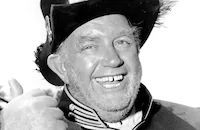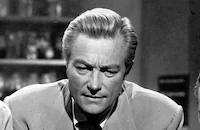Geronimo
Cast & Crew
Paul H. Sloane
Preston Foster
Ellen Drew
Andy Devine
William Henry
Ralph Morgan
Film Details
Technical Specs

Synopsis
The bloody massacre of his family by the white man imbues the Indian leader Geronimo with a fanatical hatred and an obsessive desire to drive all "palefaces" from the Southwest. In his campaign, Geronimo is aided by Gillespie, a renegade white who supplies the Indians with rifles and ammunition. To cope with the Indian unrest, the United States Army sends General Steele to the fort in Grant, Arizona. Steele, a strict disciplinarian, insists that his troops be only comprised of seasoned soldiers, and consequently, when Jack, the son he has not seen since childhood is assigned to the general's command fresh out of West Point, the general gives the boy the cold shoulder. Although he is befriended by Captain Bill Starrett and Sneezer, the Indian scout, Lieutenant Steele rebels against his father and submits his resignation. Deciding to leave the army and go to California, the lieutenant sends for his sweetheart, Alice Hamilton, who is chaperoned by his mother. However, after Alice is wounded and Mrs. Steele killed when their coach is attacked by Indians, the lieutenant decides to single-handedly eliminate Geronimo. When Geronimo captures Jack, Starrett begs the general to let him lead a rescue mission, but Steele refuses. Defying orders, Starrett rides to free Jack and is himself captured by Geronimo. Back at the fort, a remorseful general finally realizes that he has failed his family and leads a small band of men to free his son. Learning that the general has left the protected fort, Geronimo leaves his prisoners behind in a trap to ambush the soldiers. After the detachment rescues Jack and Starrett, Geronimo and his men swoop down on them and in the ensuing gun battle, the general is wounded. Defying death, Starrett and Jack ride to the fort for reinforcements, but only Jack makes it alive. As Geronimo leads his massacre on the troops, Jack leads the reinforcements to the rescue. Not to be deprived of his prey, Geronimo, disguised as a soldier, is about to deal a death blow to the general when Jack pounces upon the renegade chief, and father and son are at last reconciled.

Director
Paul H. Sloane
Cast

Preston Foster

Ellen Drew

Andy Devine

William Henry

Ralph Morgan

Gene Lockhart

Marjorie Gateson

Pierre Watkin
Chief Thunder Cloud
Kitty Kelly

Monte Blue

Addison Richards

Joseph Crehan
Hank Bell
William Haade
Stanley Andrews
Ivan Miller
Frank M. Thomas

Richard Denning
Syd Saylor
Gaylord Pendleton
Eddy Waller
Pat West
Francis Ford
William Edmunds
Russell Simpson
Jack Chapin
Phillip Warren
Archie Twitchell
Harry Templeton
Cecil Kellogg
Joe Dominguez
Davison Clark
Warren Dunaway
James Glines
Carl Sepulveda
Ted Wells
Frank Cordell
Tommy Coats
Lee Shumway
Chief Thunderbird
Hooper Atchley
Wheaton Chambers
Edward Peil Sr.
John M. Sullivan

Emmett Vogan
Harry Bailey
Ted Oliver
Charles Stevens
Allen Fox
Dorothy Vernon
Ethel Clayton
Gloria Williams
Paula De Cardo
Crew
Gerald Carbonara
Hans Dreier
Farciot Edouart
A. E. Freudeman
Earl Hedrick
Don Johnson
William Lebaron
John Leipold
Harry Lindgren
John Link
Henry Sharp
Paul H. Sloane
Paul H. Sloane
George Templeton

Film Details
Technical Specs

Articles
Ellen Drew, 1914-2003
She was born Esther Loretta "Terry" Ray on November 23, 1914, in Kansas City, Missouri. The daughter of a barber, her family moved to Chicago when she was still an infant and she lived a very quiet childhood far removed from the glamour of Hollywood. She was encouraged by some friends to enter a beauty contest when she was just 17. After winning, she tried her luck in Hollywood, but found that they were no immediate offers for her particular talents.
She eventually took a waitressing job at C.C. Brown's, a famed Hollywood Boulevard soda fountain, and had virtually abandoned her dreams as a starlet when William Demarest, a popular actor's agent and well-known character actor, spotted her. Demarest arranged a screen test for her at Paramount, and she was promptly placed under contract for $50 a week.
For the first few years, (1936-38), Drew got only bit parts, and was often uncredited. When she finally got prominent billing in the Bing Crosby musical Sing You Sinners (1938), she decided to change her name, from Terry Ray to Ellen Drew. She earned her first major role in Frank Lloyd's If I Were King (1938) opposite Ronald Colman, yet for the most part of her career, rarely rose above "B" material and second leads. Still, she had some fine exceptions: Preston Sturges' enchanting comedy Christmas in July (1940), with Dick Powell; Tay Garnett's lighthearted war romp My Favorite Spy (1942) co-starring Kay Kyser; Julien Duvivier's taut The Imposter (1944), holding her own with a brooding Jean Gabin; and Mark Robson's chilling low-budget chiller Isle of the Dead (1945) opposite Boris Karloff. Drew made some notable television appearances in the late '50s including Perry Mason and The Barbara Stanwyck Show, before retiring from the entertainment industry. She is survived by her son David; five grandchildren; and five great-grandchildren.
by Michael T. Toole

Ellen Drew, 1914-2003
Quotes
Trivia
It is claimed that Private Aubrey Eberhardt of the US Army's parachute test corps at Fort Benning, Georgia, began the practice of U.S. Army paratroopers yelling "GERONIMO!" upon exiting the airplane after he and his comrades had seen this movie the night before an important test jump in 1940.
Notes
The working title of this film was Great Enemy. According to studio press releases, some backgrounds were shot at Fort Bliss, TX. The Variety review notes that this picture marked the first use of a new fine-grain positive film, which was developed by Paramount engineers and produced by DuPont. The process lent a greater richness to the tone of the print. Although ads for the film and the New York Times credit the role of "McNeil" to William Haade, the Paramount production files and other reviews credit Frank Cordell with the role. Cordell is credited on the CBCS with the role of "Sergeant Cord." A news item in Hollywood Reporter adds that the production had to shoot around actress Kitty Kelly when Kelly spent three weeks in the hospital with a back injury. A modern source notes that writer Paul H. Sloane proposed the idea of producing this film to Paramount executives. Sloane's idea was to emulate the story of the studio's successful Lives of a Bengal Lancer and include footage from that film and other Paramount productions in order to make the film for a very low cost. Action sequences in the film also include footage from Wells Fargo, The Plainsman, The Thundering Herd and The Texas Rangers.














